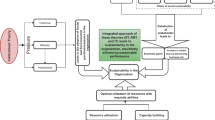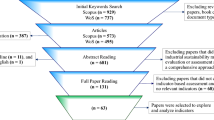Abstract
This paper presents a quantitative approach to evaluate the sustainability performance (SP) of an organization. A methodology is proposed based on principal component analysis (PCA), numerical taxonomy (NT), statistical, and cluster analysis. Related factors are determined considering sustainability dimensions, including social, economic, and environmental ones. A unique procedure is presented to commensurate the monetary factors. PCA is developed for multivariate analysis, which can rank annual records and determine factors' importance degree. NT is developed to verify and validate the results of PCA. The multivariate approach is able to rank the alternatives and simultaneously determine the importance degree of factors. An upstream oil and gas company is given as a case study. The statistical analysis showed direct relationships between the results of different analyses. In addition, the factors are categorized into two and four partitions to reduce dimensionality. The outcome-related factors are found to be of great importance for organizational SP. Furthermore, a descending SP in recent years was identified. To improve potential SP, operational planning for enhancing the performance of personnel is recommended. This paper provides intuition on the clusters obtained and why these factors affect the organizations' performance. The approach of this paper can be utilized for managers in the other industrial sectors who have access to company performance data and wish to analyze which factors are vital for company performance or hurting the company performance using the methodology presented in this paper.








Similar content being viewed by others
References
Ahi, P., Jaber, M. Y., & Searcy, C. (2016). A comprehensive multidimensional framework for assessing the performance of sustainable supply chains. Applied Mathematical Modelling, 40(23–24), 10153–10166.
Ahmad, M., Chandio, A. A., Solangi, Y. A., Shah, S. A. A., Shahzad, F., Rehman, A., & Jabeen, G. (2021). Dynamic interactive links among sustainable energy investment, air pollution, and sustainable development in regional China. Environmental Science and Pollution Research, 28(2), 1502–1518.
Ahmad, M., Jan, I., Jabeen, G., & Alvarado, R. (2021). Does energy-industry investment drive economic performance in regional China: Implications for sustainable development. Sustainable Production and Consumption, 27, 176–192.
Ahmad, M., Muslija, A., & Satrovic, E. (2021). Does economic prosperity lead to environmental sustainability in developing economies? Environmental Kuznets curve theory. Environmental Science and Pollution Research, 28(18), 22588–22601.
Alnajem, M., Mostafa, M. M., & ElMelegy, A. R. (2021). Mapping the first decade of circular economy research: A bibliometric network analysis. Journal of Industrial and Production Engineering, 38(1), 29–50.
Al-Tuwaijri, S. A., Christensen, T. E., & Hughes Ii, K. (2004). The relations among environmental disclosure, environmental performance, and economic performance: A simultaneous equations approach. Accounting, Organizations and Society, 29(5–6), 447–471.
Alves, J. A., Silva, L. T., & Remoaldo, P. C. C. (2015). The influence of low-frequency noise pollution on the quality of life and place in sustainable cities: A case study from Northern Portugal. Sustainability, 7(10), 13920–13946.
Anser, M. K., Usman, M., Godil, D. I., Shabbir, M. S., Tabash, M. I., Ahmad, M., Zamir,.A., & Lopez, L. B. (2021). Does air pollution affect clean production of sustainable environmental agenda through low carbon energy financing? Evidence from ASEAN countries. Energy and Environment.
Arıkan, E., Fichtinger, J., & Ries, J. M. (2014). Impact of transportation lead-time variability on the economic and environmental performance of inventory systems. International Journal of Production Economics, 157, 279–288.
Azadeh, A., Ghaderi, S., & Nasrollahi, M. (2011). Location optimization of wind plants in Iran by an integrated hierarchical data envelopment analysis. Renewable Energy, 36(5), 1621–1631.
Azadeh, A., Ghaderi, S., Omrani, H., & Eivazy, H. (2009). An integrated DEA–COLS–SFA algorithm for optimization and policy making of electricity distribution units. Energy Policy, 37(7), 2605–2618.
Azadeh, A., Salmanzadeh-Meydani, N., & Motevali-Haghighi, S. (2017). Performance optimization of an aluminum factory in economic crisis by integrated resilience engineering and mathematical programming. Safety Science, 91, 335–350.
Battisti, M., Beynon, M., Pickernell, D., & Deakins, D. (2019). Surviving or thriving: The role of learning for the resilient performance of small firms. Journal of Business Research, 100, 38–50.
Brandenburg, M. (2016). Supply chain efficiency, value creation and the economic crisis–An empirical assessment of the European automotive industry 2002–2010. International Journal of Production Economics, 171, 321–335.
Chen, W., Kucukyazici, B., & Saenz, M. J. (2019). On the joint dynamics of the economic and environmental performances for collective take-back systems. International Journal of Production Economics, 218, 228–244.
D’Inverno, G., Carosi, L., & Romano, G. (2020). Environmental sustainability and service quality beyond economic and financial indicators: A performance evaluation of Italian water utilities. Socio-Economic Planning Sciences, 100852.
Dal Pozzo, A., Guglielmi, D., Antonioni, G., & Tugnoli, A. (2018). Environmental and economic performance assessment of alternative acid gas removal technologies for waste-to-energy plants. Sustainable Production and Consumption, 16, 202–215.
D'Ambra, L., Crisci, A., Meccariello, G., Della Ragione, L., & Palma, R. (2020). Evaluation of the social and economic impact of carbon dioxide (CO2) emissions on sustainable mobility using a trend odds model. Socio-Economic Planning Sciences, 100817.
Das, D. (2018). Sustainable supply chain management in Indian organisations: An empirical investigation. International Journal of Production Research, 56(17), 5776–5794.
Dev, N. K., Shankar, R., & Swami, S. (2020). Diffusion of green products in industry 4.0: Reverse logistics issues during design of inventory and production planning system. International Journal of Production Economics, 223, 107519.
Ding, H., Liu, Q., & Zheng, L. (2016). Assessing the economic performance of an environmental sustainable supply chain in reducing environmental externalities. European Journal of Operational Research, 255(2), 463–480.
Elfarouk, O., Wong, K. Y., & Wong, W. P. (2021). Multi-objective optimization for multi-echelon, multi-product, stochastic sustainable closed-loop supply chain. Journal of Industrial and Production Engineering, 1–19.
Forteza, F. J., Carretero-Gomez, J. M., & Sese, A. (2017). Occupational risks, accidents on sites and economic performance of construction firms. Safety Science, 94, 61–76.
Ganda, F., & Milondzo, K. S. (2018). The impact of carbon emissions on corporate financial performance: Evidence from the South African firms. Sustainability, 10(7), 2398.
Goyal, S., Garg, D., & Luthra, S. (2021). Sustainable production and consumption: Analysing barriers and solutions for maintaining green tomorrow by using fuzzy-AHP–fuzzy-TOPSIS hybrid framework. Environment, Development and Sustainability, 1–47.
Hammad, A. W., Akbarnezhad, A., & Rey, D. (2017). Sustainable urban facility location: Minimising noise pollution and network congestion. Transportation Research Part E: Logistics and Transportation Review, 107, 38–59.
Hayami, H., Nakamura, M., & Nakamura, A. O. (2015). Economic performance and supply chains: The impact of upstream firms׳ waste output on downstream firms׳ performance in Japan. International Journal of Production Economics, 160, 47–65.
Huo, B., Gu, M., & Wang, Z. (2018). Supply chain flexibility concepts, dimensions and outcomes: An organisational capability perspective. International Journal of Production Research, 56(17), 5883–5903.
Hussain, A., Oad, A., Ahmad, M., Irfan, M., & Saqib, F. (2021). Do financial development and economic openness matter for economic progress in an emerging country? Seeking a sustainable development path. Journal of Risk and Financial Management, 14(6), 237.
Khan, S. A. R., & Qianli, D. (2017). Does national scale economic and environmental indicators spur logistics performance? Evidence from UK. Environmental Science and Pollution Research, 24(34), 26692–26705.
Król-Badziak, A., Pishgar-Komleh, S. H., Rozakis, S., & Księżak, J. (2021). Environmental and socio-economic performance of different tillage systems in maize grain production: Application of Life Cycle Assessment and Multi-Criteria Decision Making. Journal of Cleaner Production, 278, 123792.
Ledesma, R. D., Valero-Mora, P., & Macbeth, G. (2015). The scree test and the number of factors: a dynamic graphics approach. The Spanish journal of psychology, 18.
Ling-zhi, R., Xin-gang, Z., Yu-zhuo, Z., & Yan-bin, L. (2018). The economic performance of concentrated solar power industry in China. Journal of Cleaner Production, 205, 799–813.
Nishitani, K. (2011). An empirical analysis of the effects on firms’ economic performance of implementing environmental management systems. Environmental and Resource Economics, 48(4), 569–586.
Nishitani, K., & Kokubu, K. (2020). Can firms enhance economic performance by contributing to sustainable consumption and production? Analyzing the patterns of influence of environmental performance in Japanese manufacturing firms. Sustainable Production and Consumption, 21, 156–169.
Pal, R., Torstensson, H., & Mattila, H. (2014). Antecedents of organizational resilience in economic crises—an empirical study of Swedish textile and clothing SMEs. International Journal of Production Economics, 147, 410–428.
Pashapour, S., Bozorgi-Amiri, A., Azadeh, A., Ghaderi, S. F., & Keramati, A. (2019). Performance optimization of organizations considering economic resilience factors under uncertainty: A case study of a petrochemical plant. Journal of Cleaner Production, 231, 1526–1541.
Rahimi, M., Ghezavati, V., & Asadi, F. (2019). A stochastic risk-averse sustainable supply chain network design problem with quantity discount considering multiple sources of uncertainty. Computers and Industrial Engineering, 130, 430–449.
Sabbaghnia, A., Heydari, J., & Salmanzadeh-Mcydani, N. (2019). Optimization and coordination of a sustainable supply chain with emission reduction considerations. In 2019 15th Iran International Industrial Engineering Conference (IIIEC).
Sabogal-De La Pava, M. L., Vidal-Holguín, C. J., Manotas-Duque, D. F., & Bravo-Bastidas, J. J. (2021). Sustainable supply chain design considering indicators of value creation. Computers and Industrial Engineering, 107294.
Salmanzadeh-Meydani, N., & Fatemi Ghomi, S. (2019). The causal relationship among electricity consumption, economic growth and capital stock in Iran. Journal of Policy Modeling, 41(6), 1230–1256.
Schwab, L., Gold, S., & Reiner, G. (2019). Exploring financial sustainability of SMEs during periods of production growth: A simulation study. International Journal of Production Economics, 212, 8–18.
Shan, S., Ahmad, M., Tan, Z., Adebayo, T. S., Li, R. Y. M., & Kirikkaleli, D. (2021). The role of energy prices and non-linear fiscal decentralization in limiting carbon emissions: Tracking environmental sustainability. Energy, 234, 121243.
Shirali, G. A., Mohammadfam, I., Ebrahimipour, V., & Safety, S. (2013). A new method for quantitative assessment of resilience engineering by PCA and NT approach: A case study in a process industry. Reliability Engineering and System Safety, 119, 88–94.
Shirali, G. A., Shekari, M., & Angali, K. (2016). Quantitative assessment of resilience safety culture using principal components analysis and numerical taxonomy: A case study in a petrochemical plant. Journal of Loss Prevention in the Process Industries, 40, 277–284.
Singh, A., & Misra, S. C. (2021). Safety performance & evaluation framework in Indian construction industry. Safety science, 134, 105023.
Solangi, Y. A., Longsheng, C., Shah, S. A. A., Alsanad, A., Ahmad, M., Akbar, M. A., Ahmad, M., Akbar, M. A., Gumaei, A., & Ali, S. (2020). Analyzing renewable energy sources of a developing country for sustainable development: an integrated fuzzy based-decision methodology. Processes, 8(7), 825.
Taherdangkoo, M., Ghasemi, K., & Beikpour, M. (2017). The role of sustainability environment in export marketing strategy and performance: A literature review. Environment, Development and Sustainability, 19(5), 1601–1629.
Toutounchian, S., Abbaspour, M., Dana, T., & Abedi, Z. (2018). Design of a safety cost estimation parametric model in oil and gas engineering, procurement and construction contracts. Safety Science, 106, 35–46.
Tsao, Y.-C., Thanh, V.-V., Lu, J.-C., & Yu, V. (2018). Designing sustainable supply chain networks under uncertain environments: Fuzzy multi-objective programming. Journal of Cleaner Production, 174, 1550–1565.
Tseng, M.-L., Tran, T. P. T., Ha, H. M., Bui, T.-D., & Lim, M. K. (2021). Sustainable industrial and operation engineering trends and challenges Toward Industry 4.0: A data driven analysis. Journal of Industrial and Production Engineering, 1–18.
Wilcoxon, F., Katti, S., & Wilcox, R. A. (1970). Critical values and probability levels for the Wilcoxon rank sum test and the Wilcoxon signed rank test. Selected Tables in Mathematical Statistics, 1, 171–259.
Zhong, Y., & Wu, P. (2015). Economic sustainability, environmental sustainability and constructability indicators related to concrete-and steel-projects. Journal of Cleaner Production, 108, 748–756.
Author information
Authors and Affiliations
Corresponding author
Additional information
Publisher's Note
Springer Nature remains neutral with regard to jurisdictional claims in published maps and institutional affiliations.
Rights and permissions
About this article
Cite this article
Salmanzadeh-Meydani, N., Ghomi, S.M.T.F., Haghighi, S.S. et al. A multivariate quantitative approach for sustainability performance assessment: An upstream oil and gas company. Environ Dev Sustain 25, 2777–2807 (2023). https://doi.org/10.1007/s10668-022-02112-0
Received:
Accepted:
Published:
Issue Date:
DOI: https://doi.org/10.1007/s10668-022-02112-0




